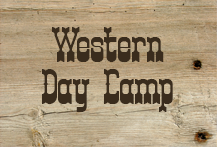 It’s time to saddle up the horses, put on your boots and cowboy hat and round up your Cub Scouts. Explore the wild and wooly West. Learn about the Chisholm Trail and its hardships. Locate on a map the actual route that the cattle drive took. Find out what the cowboys wore and the safety reason for each garment. Learn about leather and rope-making crafts. Plan a field trip to see horses and wagons or learn about Western history. Learn to sing "Home on the Range" and other western songs. Experience trail food as everyone tries beans and jerky for dinner.
It’s time to saddle up the horses, put on your boots and cowboy hat and round up your Cub Scouts. Explore the wild and wooly West. Learn about the Chisholm Trail and its hardships. Locate on a map the actual route that the cattle drive took. Find out what the cowboys wore and the safety reason for each garment. Learn about leather and rope-making crafts. Plan a field trip to see horses and wagons or learn about Western history. Learn to sing "Home on the Range" and other western songs. Experience trail food as everyone tries beans and jerky for dinner.
As the pioneers headed west across this great country, they met many difficulties, yet they did not give up. Instead, they kept going, overcame the adversities they met, and helped to develop our wonderful country. Perseverance is defined as sticking with something and not giving up, even if it is difficult.
Texas Badge
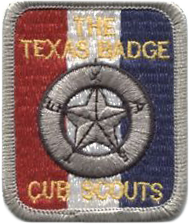
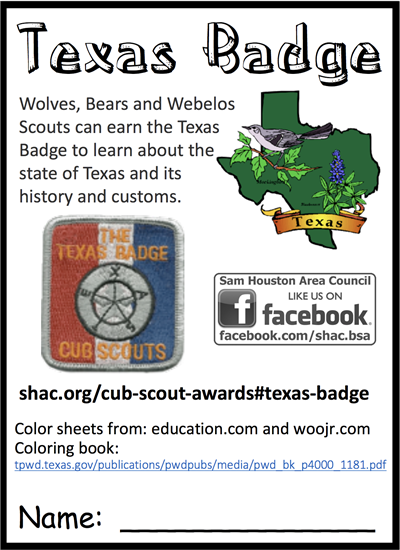 Cub Scouts in 2nd - 5th grade can work on the Texas Badge and to learn about the state of Texas and its history and customs. Before printing the passport, save the document to your computer and then follow the instructions.
Cub Scouts in 2nd - 5th grade can work on the Texas Badge and to learn about the state of Texas and its history and customs. Before printing the passport, save the document to your computer and then follow the instructions.
Texas Badge Passport Requirements Order awards
The volunteer committee is working on updating these resources with the most recent advancement changes, including the addition of girls and Lions. If you find any errors, suggestions for changes, improvements, or additional ideas, let us know.
Western Theme Ideas
Pack meeting and blue and gold banquet ideas including skits, songs, advancement ceremonies, opening/closing ceremonies and more can be found in our theme ideas:
Western Theme Ideas (.pdf) - coming soon .doc version
Placemats
 Texas-themed placemats can be to used as a gathering activity to help promote day camp. Print one-sided to two-sided. Before printing, insert the date, time, location and web URL of your district day camp on page 2.
Texas-themed placemats can be to used as a gathering activity to help promote day camp. Print one-sided to two-sided. Before printing, insert the date, time, location and web URL of your district day camp on page 2.
Texas Placemat 8.5x11 Texas Placemat 8.5x14
Pinterest
 Visit our western-themed Pinterest boards on the council Pinterest page for more ideas.
Visit our western-themed Pinterest boards on the council Pinterest page for more ideas.
Western Theme Pinterest Board
Blue and Gold Banquet Ideas
Blue and gold banquet ideas including skits, songs, advancement ceremonies, opening/closing ceremonies and more can be found in our theme ideas.
Blue and Gold Banquet Ideas (coming soon) (.pdf) (.doc)
Pack Meetings. The pack meeting brings all of the dens in the pack together for the purposes of recognizing the achievements of the Cub Scouts, communicating information about upcoming events, and providing a program that enriches the Cub Scouting experience. It helps the Cubs realize their den is part of a larger organization. A good pack meeting is well planned and well organized. Packs meet several times during the year – there is no required number. Some packs meet monthly, others less often.
Resources: BSA Pack Meeting Resources, and Pack Meeting Tips
Blue and Gold Banquet: Most packs celebrate Scouting Anniversary Week in February with a birthday party, called the blue and gold banquet; some packs do end-of-the-year banquets. It brings families together for fun and cheer. The purpose of a banquet is to celebrate Scouting, thank leaders and volunteers and inspire the leaders, Scouts, and parents. The banquet can be like a regular pack meeting with songs, skits, stunts and awards, or it can be something different and a little more special. The pack committee may decide to bring in an entertainer, such as a mad scientist or magician, and have a video or slideshow year in review. A good banquet needs lot of careful planning to be successful; start planning at least two months in advance. The pack committee should recruit a banquet chair, who in turn may select others to carry out the responsibilities of the program, such as making physical arrangements, promotions, inviting special guests, decorations, choosing a theme, ordering food, etc. A detailed plan for banquets, including a planning calendar, sample agenda, and suggested program activities, is available in the Cub Scout Leader How-To Book, No. 621165.
Resources: Blue and Gold Theme Ideas


Advancement Ceremony. Recognition is important to Cub Scouts. Each one represents a great amount of time and effort on the part of the Cub Scout, family, and leaders and should be presented in a special ceremony. The presentation should be worthy of the award and the work that went into it. When Cub Scouts are recognized for their accomplishments, they are motivated to achieve more. Memories of meaningful, impressive ceremonies will last years. Depending on the advancements that you have for each month’s pack meeting, you’ll need to adapt ceremonies. Delete sections that relate to a badge that you are not presenting or change that section to a narrative form in place of the badge presentation. Use your imagination to make the ceremonies work for you. A variety of leaders can be involved in the advancement ceremony (e.g., advancement chair, Cubmaster, assistant Cubmasters, den leaders, den chiefs). Use simple props and costumes to enhance ceremonies. Some ceremonies will be simple (monthly awards) while others are more involved (e.g., rank ceremonies, crossover ceremonies, Arrow of Light ceremonies). Find advancement ceremonies in the Cub Scout Den and Pack Ceremonies, No. 33212.
Advancement Ceremonies:


Audience Participation stories add variety, action, and fun to pack meetings. Some include motions. Some require the audience to be dived into groups that respond to a keyword in a story read by a leader. It’s a good idea to let groups practice their motions or phrases first. Find audience participation skits in the Cub Scout Leader How-To Book, No. 621165.
Audience Participation:


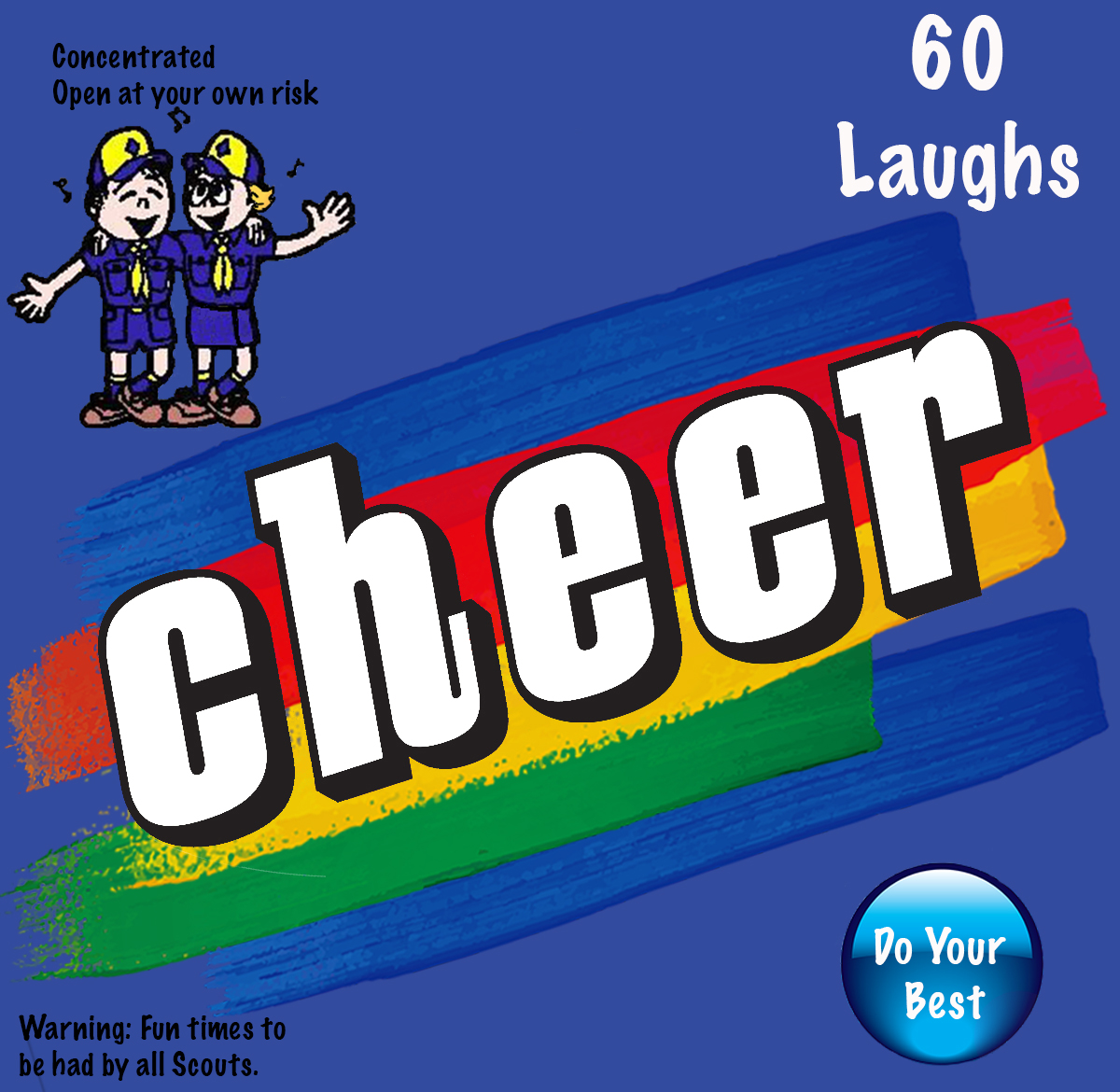 Cheers. Silly cheers and applauses are a great way to recognize Scouts and Scouters at den or pack meetings for accomplishments and performances. Cheers and applauses add fun to den meetings, pack meetings, and campfire programs. Learn more about cheers and how to make a cheer box.
Cheers. Silly cheers and applauses are a great way to recognize Scouts and Scouters at den or pack meetings for accomplishments and performances. Cheers and applauses add fun to den meetings, pack meetings, and campfire programs. Learn more about cheers and how to make a cheer box.
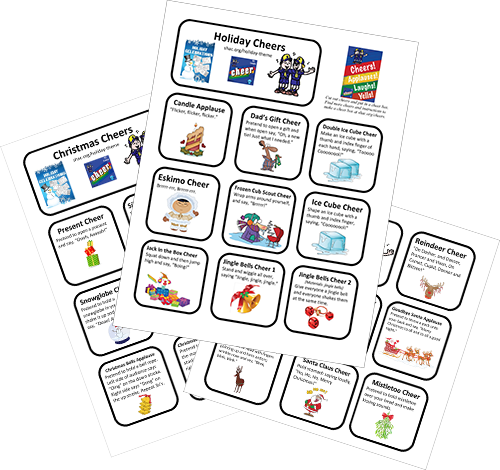


Closing: the closing ceremony draws the meeting to an end. It’s usually serious and quiet and provides an opportunity to present a brief character lesson, a simple thought. Keep it simple.
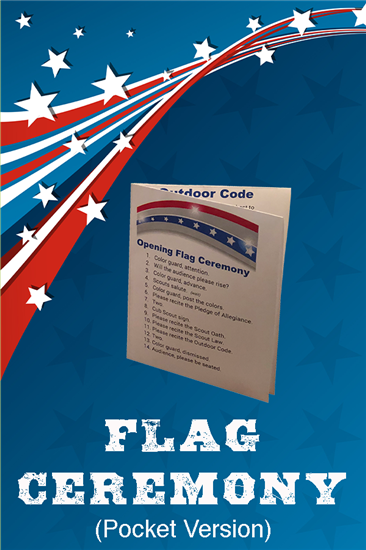 Flag Ceremony: Pre-select a den to lead the pledge and have the den leader practice flag etiquette with the Scouts for several meetings prior. The same den that conducted the opening can also conduct the opening ceremony. Consider group recitation of the Scout Law, Scout Oath and Outdoor Code after the pledge. The pocket guide can assist the Scouts: /Data/Sites/1/media/instep/flag-ceremony.pdf.
Flag Ceremony: Pre-select a den to lead the pledge and have the den leader practice flag etiquette with the Scouts for several meetings prior. The same den that conducted the opening can also conduct the opening ceremony. Consider group recitation of the Scout Law, Scout Oath and Outdoor Code after the pledge. The pocket guide can assist the Scouts: /Data/Sites/1/media/instep/flag-ceremony.pdf.


Cubmaster Minute. At the end of a pack meeting filled with learning, fun, and fellowship comes the grand finale, the Cubmaster Minute. Consider it a closing argument to your Scouts — one last chance to inspire before they head home. Find a message that’s relevant, powerful, and memorable that can be crammed into 60 seconds. It’s an opportunity to quiet the Cub Scouts and put them in a reflective mood before departing.
Cubmaster Minute:


Den & Pack Activities:


Games can be an outlet for excess energy and teach sportsmanship, skills, life lessons, following rules, turn-taking, fair play, Games selected should be fun to play and fun to watch. Everyone should be able to participate. Consider the age of participants, physical arrangements, equipment, and safety.
Games:


Gathering Activities. As the Cub Scouts begin to arrive, they join in an informal activity (e.g., activity sheet) or game, often conducted by the den chief to keep everyone interested and active until the entire group has arrived. The gathering activity must be done prior to the formal start of the meeting as it encourages everyone to arrive on time so the meeting can start on time. Consider assigning greeters at the door to welcome Cub Scouts, guests, and families to the pack meeting.
Gathering Activity:


Invocations. (Source) When present, members of the clergy, other religious leaders, or the chaplain aide may be asked to lead the unit in prayer. If the group consists of members with mixed beliefs, or if the beliefs of the group are unknown, then prayers should be of an interfaith content. However, if the group is of like belief or the unit is chartered to a religious organization, then it is entirely appropriate to offer belief specific prayer.
Some basic guidelines: • The word God generally is accepted by most faith groups and is the term used in all phases of Scouting. Note that this term represents the creator or divine spirit, as it is used in the Scout Oath. It is not intended to be a limiting term—there are many names that individual religions use to represent God. • Other than God, specific names should be avoided (such as Buddha, Jesus, Mohammed, or Holy Spirit) since they are religion-specific. Likewise, male pronouns (such as Father God, Heavenly Father, or His) should be avoided if possible as they may be disrespectful in some religions.
Invocations, benedictions, and devotions with interfaith content are available in the pamphlet A Scout Is Reverent: A Resource for Interfaith, Christian, Jewish, and Muslim Worship at Scouting Events, No. 34248.
Invocation:


Leader Recognition (for banquets and other meetings as appropriate). When working with volunteers, thanks is the only payment we can really give them. Public recognition is the most valued form of payback for volunteers – so remember to recognize parents, leaders and others who help the program! Consider a handwritten thank you note, homemade award, certificate of appreciation, or gift from the Scout Shop. Consider submitting pack leaders for adult awards and recognitions (e.g., training awards) or district awards that they qualify for and presenting them at the blue and gold banquet.
Adult Recognition


Opening: The opening ceremony is the official start of the meeting and sets the stage. It can reinforce the purpose of Scouting and help make the Scouting ideals meaningful through the words and pictures of the ceremony. One of the points of the Scout Law can be highlighted each month. Be aware of physical and/or mental disability challenges. Be sensitive that not all youth may be able to read or talk in front of a group. Adapt ceremonies in a sensitive way to involve everyone at the level they will feel comfortably involved. Pre-select a den to lead the opening ceremony and have the den leader practice with the Scouts for several meetings prior. Have posters with a picture on one side and the script printed with large letters on the back. Teach the Scouts how to talk with their head up and project their voice to the people in the back of the room. Find opening ceremonies in the Cub Scout Den and Pack Ceremonies, No. 33212.
 Flag Ceremony: Pre-select a den to lead the pledge and have the den leader practice flag etiquette with the Scouts for several meetings prior. The same den that conducted the opening can also conduct the opening ceremony. Consider group recitation of the Scout Law, Scout Oath and Outdoor Code after the pledge. The pocket guide can assist the Scouts: /Data/Sites/1/media/instep/flag-ceremony.pdf.
Flag Ceremony: Pre-select a den to lead the pledge and have the den leader practice flag etiquette with the Scouts for several meetings prior. The same den that conducted the opening can also conduct the opening ceremony. Consider group recitation of the Scout Law, Scout Oath and Outdoor Code after the pledge. The pocket guide can assist the Scouts: /Data/Sites/1/media/instep/flag-ceremony.pdf.
Opening Ceremony:


Poem:

Skits Run-ons Jokes

Skits appeal to Cub Scouts. Acting comes naturally to many Cub Scouts, and help channel youth imagination. Skits give a chance for creative expression, gaining self-confidence, and teamwork and cooperation. Some shy kids may not want to take part in skits and might be given responsibilities for handling props or “directing.” Have a den leader select a skit and practice for several meetings prior. The Cub Scouts should be taught how to talk clearly, slowly, loudly and to the back row of the audience (or speaking into the microphone correctly). Skits can be found in the Cub Scout Leader How-To Book, No. 621165.
Skit:


Run-ons are similar to skits but are much shorter and require only one or two people. Run-ons are good for a change of pace during pack meetings and campfires – something to make everyone laugh and relax. They come in handy as fill-ins between acts to fill dead time or to enliven the program.
Run-Ons:

Jokes can make meetings more entertaining. Kids love really funny clean jokes whether they are silly, gross, or dumb. Find appropriate jokes in Boys' Life.
Jokes:


Songs. Singing builds pack spirit and enthusiasm. Singing gives Cub Scouts a chance to let off steam. Singing is fun! Use a song or two to set the mood for meetings, to get the audience moving and get rid of those wiggles or to quiet and calm the group when it’s time to go. Have a few songs ready to use as fillers during transition times. Pre-select a den to lead a song in the meeting handout. Songs can be found in the Cub Scout Leader How-To Book, No. 621165 and Cub Scout Songbook, No. 33222.

Contact
For feedback on our pack meeting ideas, leader resources, and program planning resources, contact darlene.scheffler@gmail.com.